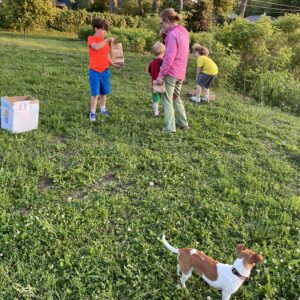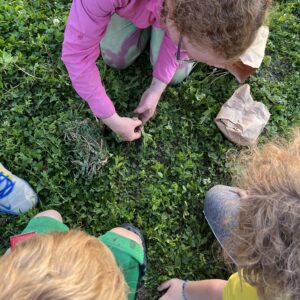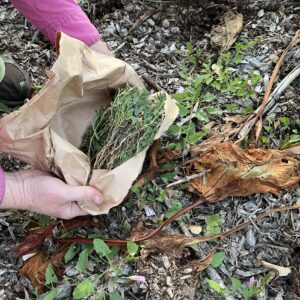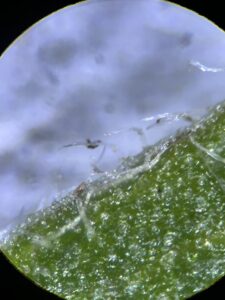Progress report for FNC25-1445
Project Information
We are Mark and Michelle Brannen, a husband and wife team that own and operate a 1.5 acre farm in Omaha, NE. It is our tenth year developing our property and we currently have about one acre under production. We sell a variety of fresh produce, herbs and flowers throughout the growing season as well as preserve our harvests to make value-added farm products each year. Currently, about ¾ of our growing space is dedicated to perennials like fruit trees, berry bushes, native plants, culinary herbs, rhubarb, sunchokes and pollinator flowers. The other ¼ is dedicated to annual vegetable and flower production.
Over the past 10 years, we have used the following soil coverage and weed suppression methods: compost to top off annual beds, wood chips to mulch pathways in between garden beds, sheet mulching to block off new garden spaces, and a variety of mulch for beds like dried leaves and straw. We have experimented with numerous sustainable agricultural tools for pest management, erosion control, and creating landscape diversity. Additionally, we have coordinated and completed other grant projects, including this one through SARE: FNC19-1156. We have also hosted a number of field trips for community not-for-profits, high school students, and horticulture students from the local community colleges. We have developed strong connections with other local growers and community organizations, and have been invited to many events as guest speakers on the topic of sustainable agriculture. Our strong backgrounds in public speaking and adult education make us well suited to spread the results of our project through on-farm demonstrations and community outreach.
Over the past year, we have read extensively about using gall mites as a biological control method for Field Bindweed. Through our research, we have made new community connections which have afforded us additional knowledge and support. We understand how to spread the gall mites through the two dispersal methods that we will highlight in the proposal. All of this coupled with our knowledge and experience make us well-equipped to carry out this project successfully.
We have utilized many weed suppression methods and still struggle with Field Bindweed. It sprouts up through sheet mulched areas, pathways, garden beds, and all over the lawn and fence line. Bindweed is mainly an issue on cultivated land but it also thrives in non-cultivated areas. It is extremely difficult to manage due to its deep taproot system; it has a growth habit of winding around other plants which helps it outcompete surrounding vegetation. Bindweed is a perennial and its seeds can be viable for 30+ years, making it nearly impossible to get rid of. In summary, bindweed is problematic and traditional mulching and smothering methods are not successful.
This past year, our research into gall mites began after a conversation we had with a friend who is a Master Gardener. These issues came up during our search and we want to learn more: 1) there is limited research from our geographical area on the biological control of bindweed through the use of gall mites, 2) we could not find research that had been conducted in a small-scale diverse setting, 3) there are few documented results from utilizing this treatment method and 4) there is limited access to the mites.
Solution:
We will study the impact of gall mites on Field Bindweed at our small-scale sustainable farm in Omaha, Nebraska. This biocontrol method employs a mite, Aceria malherbae, to infest the bindweed by forming a leaf gall which is where the mites populate and continue feeding on the plant. These particular mites feed only on bindweed; they move to a new location full of bindweed after killing off the first area. Field Bindweed can be controlled and sometimes killed in the first year of mite infestation, but it often takes 2-3 years for the plant to die completely. Human intervention can help spread the mite. However, the research we were able to find has been conducted in large-scale monocrop environments like soybean and wheat fields.
In our first test plot, we will mow after one month which can help spread the mite infestation to surrounding areas of bindweed. The estimated time for releases to be shipped is May of 2025; we will mow this test plot June through September during the first year and at regular intervals in 2026.
In the second test plot, we will install the mites in the garden. We will cut six inch stems of infested bindweed once a month in July-September in 2025 for mite dispersal; during 2026 we will disperse infested stems May-September. Stems will be taken to new bindweed plants within the test plot. We will wind that plant around the infested cut stem so the mites may begin their work on more bindweed. We will compare the efficiency of the two dispersal methods through recordkeeping.
Notes taken will include a description of release locations, dispersal method, damage observed, date/climate, photographs, and all continued manual weeding efforts needed in this area. Measurements of the damaged area (or killed off plants) on test plot bindweed will be noted, ie: 2” of damaged stem, furled leaves, 75% damaged. We will record for comparison the number of labor hours needed to maintain a control plot where bindweed is present but mites are not. Here we will use traditional weeding/mulching methods. All research plot sizes will be 20 ft in diameter although the test plots may increase in size as we disperse the mites; plots and all mite dispersal impact will be marked with flags.
One of the only insectaries nationwide with gall mites is the Palisade Insectary within the Colorado Department of Agriculture. Last spring, we contacted Scott Erthum, Weed Superintendent of Brown County, NE, who guided us in our search for mites; earlier this fall, he provided us with his USDA permit number which was a necessary step in order to be on the waiting list at the Palisade Insectary. Payment for and receiving shipments of the mites will take place in spring of 2025. Nina Louden, Biocontrol Specialist at the Colorado Department of Agriculture, answered our questions and processed the permit so that we are on the waiting list for next spring.
Objectives:
The main objectives of our project is to inspect and document the efficiency of the use of this biocontrol method in a small-scale setting. We will spread the mite infestation in two different ways and complete monthly inspections throughout two years to better understand the impact of dispersing the mite infestation. In the first test plot, the released mite infestation will be allowed to grow for one month before mowing. In the second test plot, we will install the mites in a garden area and use a manual dispersal method.
Research
Nina, our contact at the Palisade Insectary, confirmed on May 21, 2025 that we would be receiving the gall mites within the next few days. Later this same day, we measured and mapped out where we would introduce the releases in our yard, both on a mulched pathway in a garden space as well as in the lawn where we would be mowing throughout the growing season. Flags were stuck into the ground on all four sides of these areas as well as the are that we would continue to manually maintain the bindweed. By this time of year, the bindweed had been growing for some time and was several inches long in each area.
We received the gall mite shipment the Palisade Insectary at Colorado University Department of Agriculture on May 23, 2025. As instructed, we situated the releases right away.
Unfortunately, the gall mites were slow to establish their first year. After months of not seeing any visible impact with the naked eye, we took samples from each release site and put them under a microscope earlier this fall. We reached out to our contact at the Palisade Insectary with a few photos, including these ones. They said to give the gall mites a little more time, and if they overwinter successfully, we should be able to see that visible impact by next spring/summer.
Educational & Outreach Activities
Participation Summary:
In 2025, we used our newsletter, social media posts, emails, phone calls, and a Google form to communicate with members of our community about our grant project. During events this summer, two different individuals also asked about the project while they were here in-person. Twelve individuals signed up to learn more through future field days and final publications of our project results. Three of those individuals are with larger urban agriculture organizations here in the Omaha area.




